Risk Management Plan: High-Speed Train Network Project Analysis
VerifiedAdded on 2020/10/22
|22
|4981
|493
Report
AI Summary
This report details a comprehensive risk management plan for a high-speed train network project connecting Brisbane and Melbourne, aiming to reduce travel time. The executive summary highlights the project's scope, objectives, and private funding with government approval, emphasizing the importance of risk identification and mitigation. The report includes a table of contents and covers key aspects such as project information, scope, objectives, and the risk management process. It details communication and consultation plans, stakeholder analysis, and establishing context, including internal and external factors, risk criteria, and stakeholder roles. The risk assessment process is thoroughly examined, including identification methods, risk analysis, and evaluation. The report also explores risk treatment options and outlines monitoring and review processes. The project involves a privately funded high-speed train network between Brisbane and Melbourne which is designed to boost the economy of Australia.
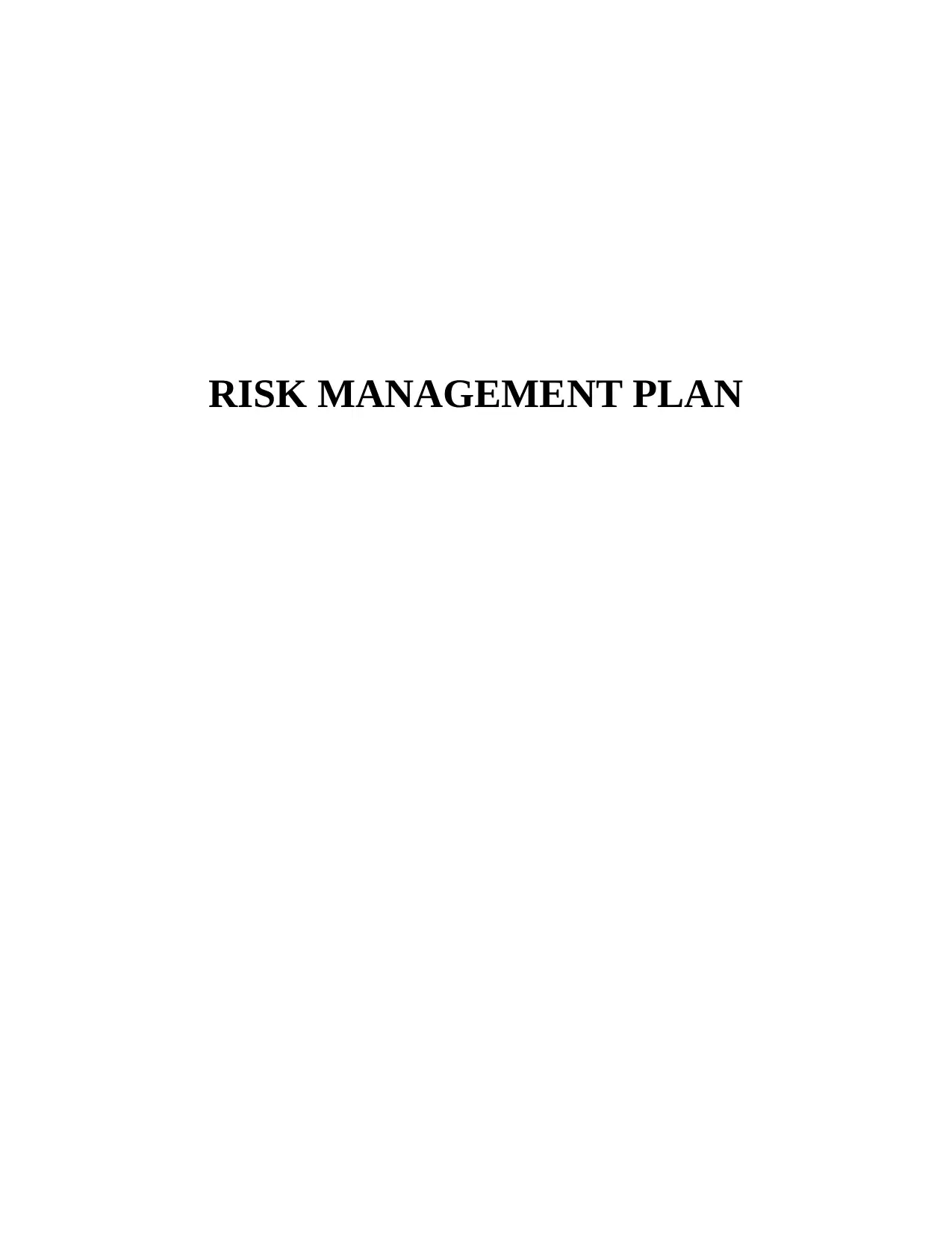
RISK MANAGEMENT PLAN
Paraphrase This Document
Need a fresh take? Get an instant paraphrase of this document with our AI Paraphraser
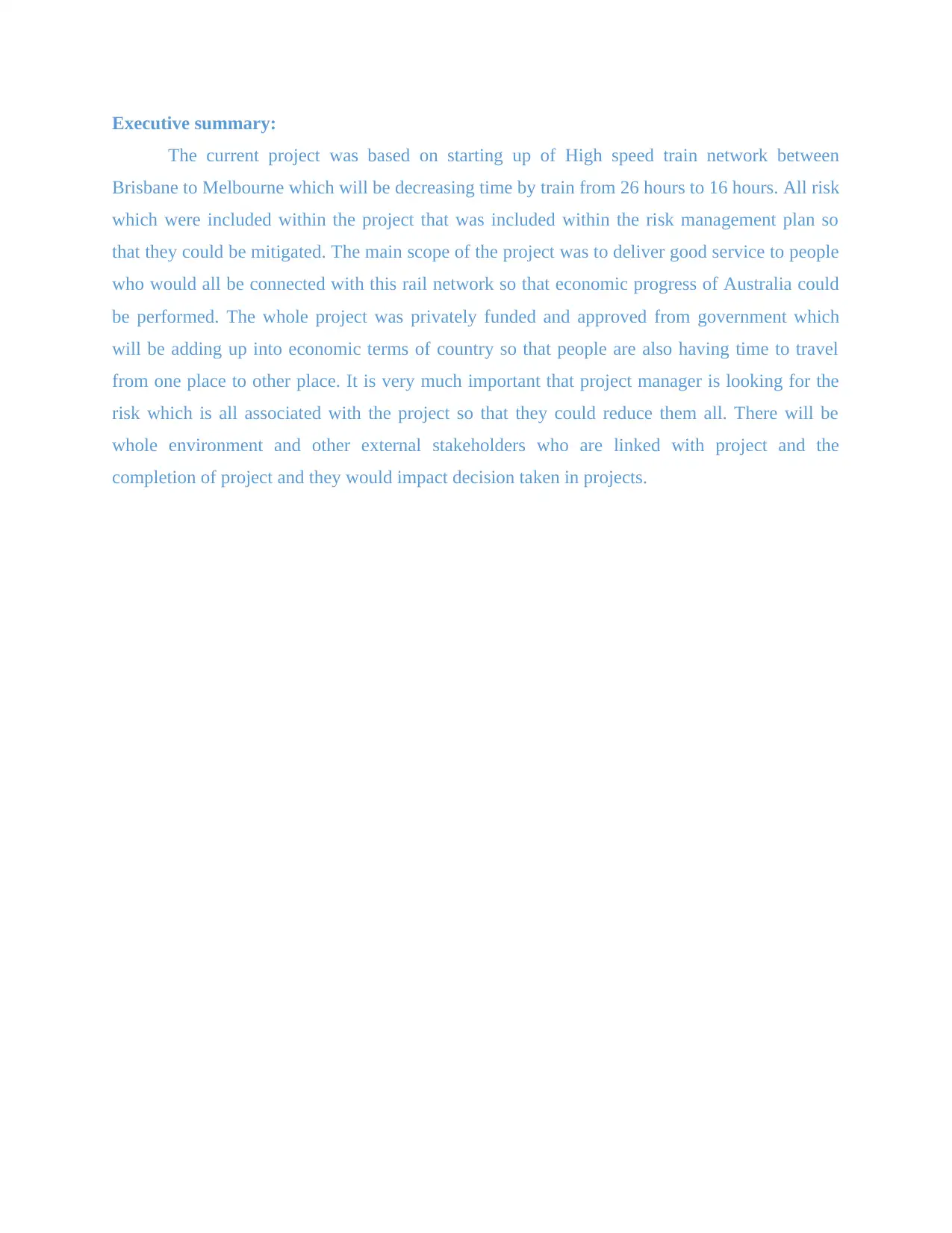
Executive summary:
The current project was based on starting up of High speed train network between
Brisbane to Melbourne which will be decreasing time by train from 26 hours to 16 hours. All risk
which were included within the project that was included within the risk management plan so
that they could be mitigated. The main scope of the project was to deliver good service to people
who would all be connected with this rail network so that economic progress of Australia could
be performed. The whole project was privately funded and approved from government which
will be adding up into economic terms of country so that people are also having time to travel
from one place to other place. It is very much important that project manager is looking for the
risk which is all associated with the project so that they could reduce them all. There will be
whole environment and other external stakeholders who are linked with project and the
completion of project and they would impact decision taken in projects.
The current project was based on starting up of High speed train network between
Brisbane to Melbourne which will be decreasing time by train from 26 hours to 16 hours. All risk
which were included within the project that was included within the risk management plan so
that they could be mitigated. The main scope of the project was to deliver good service to people
who would all be connected with this rail network so that economic progress of Australia could
be performed. The whole project was privately funded and approved from government which
will be adding up into economic terms of country so that people are also having time to travel
from one place to other place. It is very much important that project manager is looking for the
risk which is all associated with the project so that they could reduce them all. There will be
whole environment and other external stakeholders who are linked with project and the
completion of project and they would impact decision taken in projects.
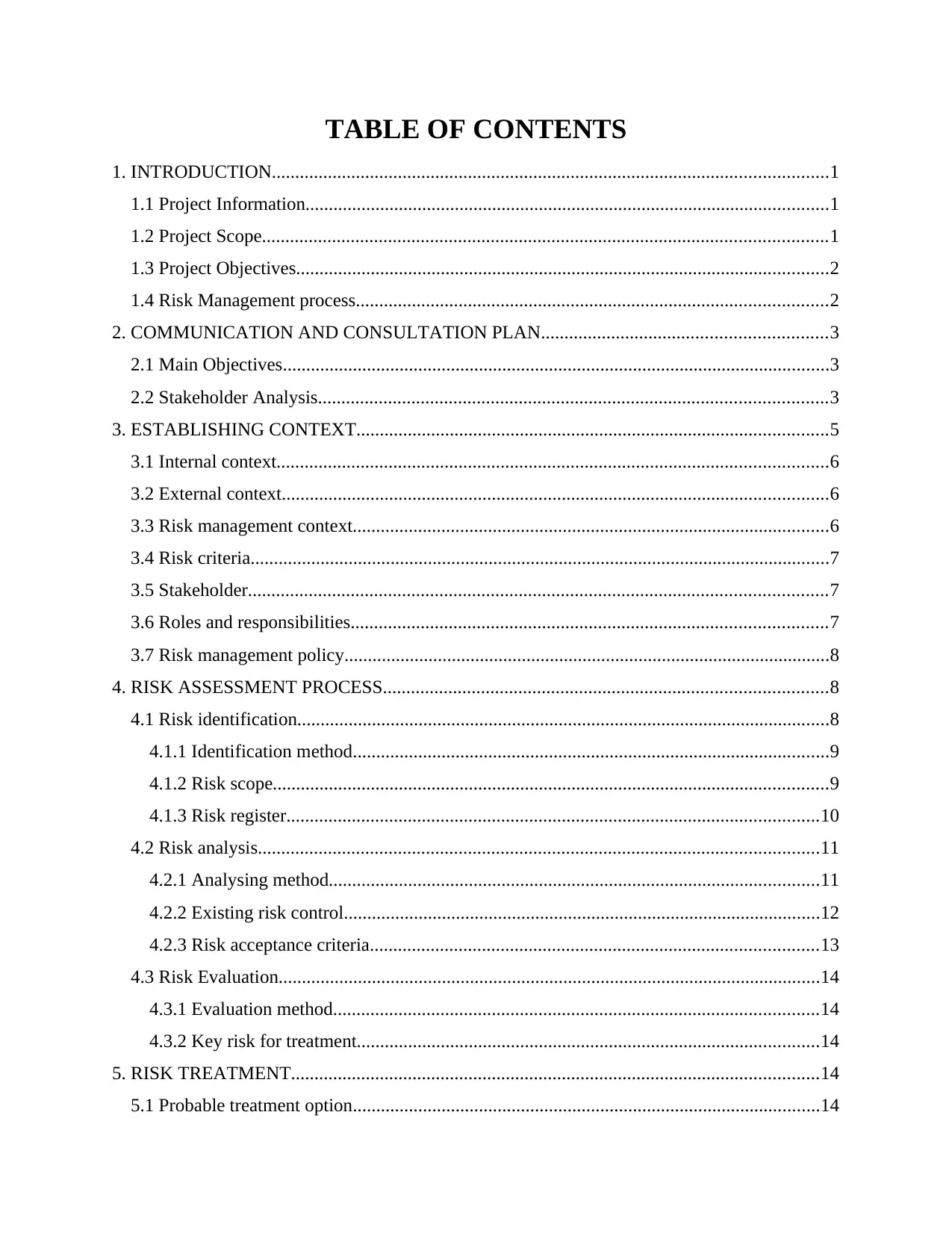
TABLE OF CONTENTS
1. INTRODUCTION.......................................................................................................................1
1.1 Project Information................................................................................................................1
1.2 Project Scope.........................................................................................................................1
1.3 Project Objectives..................................................................................................................2
1.4 Risk Management process.....................................................................................................2
2. COMMUNICATION AND CONSULTATION PLAN.............................................................3
2.1 Main Objectives.....................................................................................................................3
2.2 Stakeholder Analysis.............................................................................................................3
3. ESTABLISHING CONTEXT.....................................................................................................5
3.1 Internal context......................................................................................................................6
3.2 External context.....................................................................................................................6
3.3 Risk management context......................................................................................................6
3.4 Risk criteria............................................................................................................................7
3.5 Stakeholder............................................................................................................................7
3.6 Roles and responsibilities......................................................................................................7
3.7 Risk management policy........................................................................................................8
4. RISK ASSESSMENT PROCESS...............................................................................................8
4.1 Risk identification..................................................................................................................8
4.1.1 Identification method......................................................................................................9
4.1.2 Risk scope.......................................................................................................................9
4.1.3 Risk register..................................................................................................................10
4.2 Risk analysis........................................................................................................................11
4.2.1 Analysing method.........................................................................................................11
4.2.2 Existing risk control......................................................................................................12
4.2.3 Risk acceptance criteria................................................................................................13
4.3 Risk Evaluation....................................................................................................................14
4.3.1 Evaluation method........................................................................................................14
4.3.2 Key risk for treatment...................................................................................................14
5. RISK TREATMENT.................................................................................................................14
5.1 Probable treatment option....................................................................................................14
1. INTRODUCTION.......................................................................................................................1
1.1 Project Information................................................................................................................1
1.2 Project Scope.........................................................................................................................1
1.3 Project Objectives..................................................................................................................2
1.4 Risk Management process.....................................................................................................2
2. COMMUNICATION AND CONSULTATION PLAN.............................................................3
2.1 Main Objectives.....................................................................................................................3
2.2 Stakeholder Analysis.............................................................................................................3
3. ESTABLISHING CONTEXT.....................................................................................................5
3.1 Internal context......................................................................................................................6
3.2 External context.....................................................................................................................6
3.3 Risk management context......................................................................................................6
3.4 Risk criteria............................................................................................................................7
3.5 Stakeholder............................................................................................................................7
3.6 Roles and responsibilities......................................................................................................7
3.7 Risk management policy........................................................................................................8
4. RISK ASSESSMENT PROCESS...............................................................................................8
4.1 Risk identification..................................................................................................................8
4.1.1 Identification method......................................................................................................9
4.1.2 Risk scope.......................................................................................................................9
4.1.3 Risk register..................................................................................................................10
4.2 Risk analysis........................................................................................................................11
4.2.1 Analysing method.........................................................................................................11
4.2.2 Existing risk control......................................................................................................12
4.2.3 Risk acceptance criteria................................................................................................13
4.3 Risk Evaluation....................................................................................................................14
4.3.1 Evaluation method........................................................................................................14
4.3.2 Key risk for treatment...................................................................................................14
5. RISK TREATMENT.................................................................................................................14
5.1 Probable treatment option....................................................................................................14
⊘ This is a preview!⊘
Do you want full access?
Subscribe today to unlock all pages.

Trusted by 1+ million students worldwide
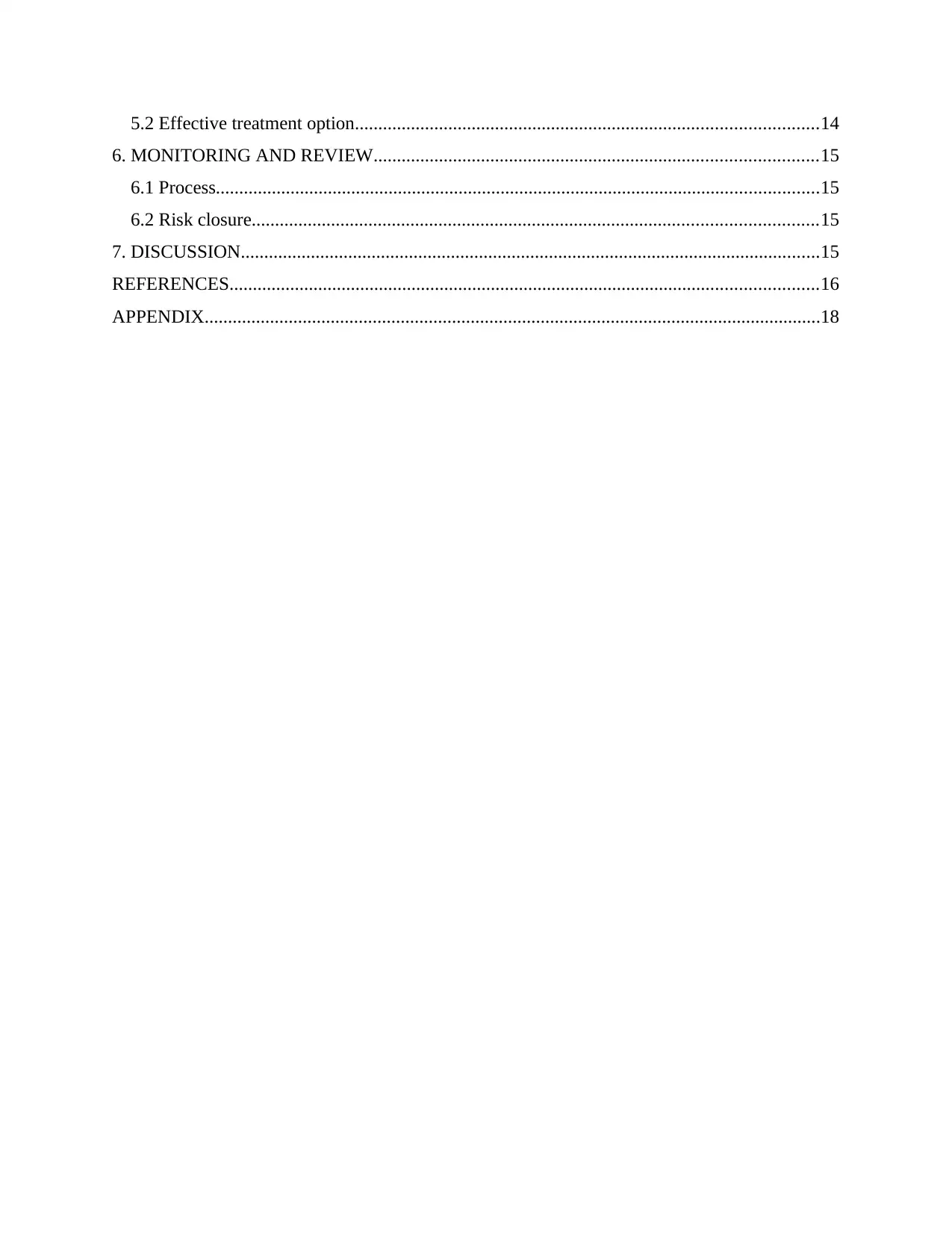
5.2 Effective treatment option...................................................................................................14
6. MONITORING AND REVIEW...............................................................................................15
6.1 Process.................................................................................................................................15
6.2 Risk closure.........................................................................................................................15
7. DISCUSSION............................................................................................................................15
REFERENCES..............................................................................................................................16
APPENDIX....................................................................................................................................18
6. MONITORING AND REVIEW...............................................................................................15
6.1 Process.................................................................................................................................15
6.2 Risk closure.........................................................................................................................15
7. DISCUSSION............................................................................................................................15
REFERENCES..............................................................................................................................16
APPENDIX....................................................................................................................................18
Paraphrase This Document
Need a fresh take? Get an instant paraphrase of this document with our AI Paraphraser
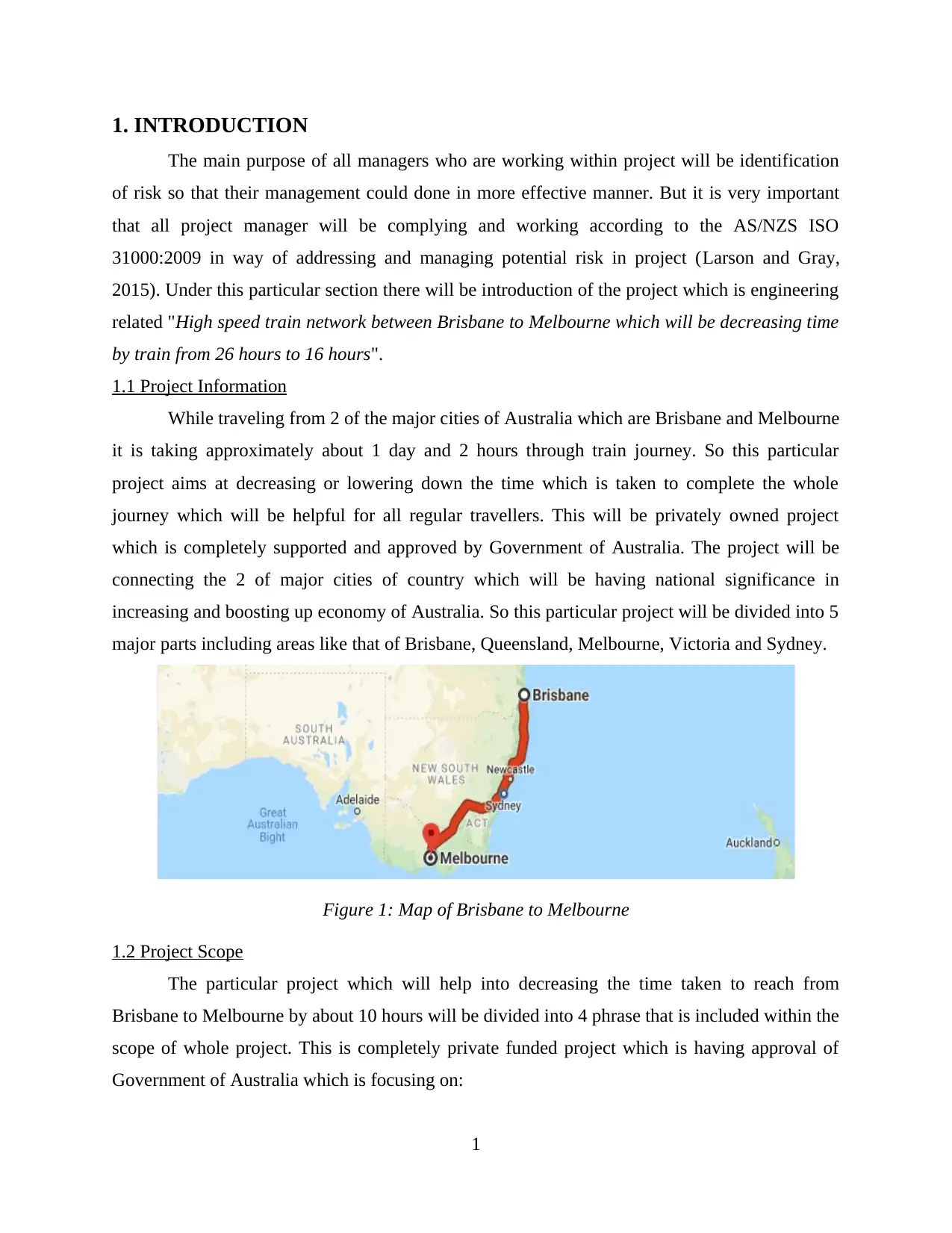
1. INTRODUCTION
The main purpose of all managers who are working within project will be identification
of risk so that their management could done in more effective manner. But it is very important
that all project manager will be complying and working according to the AS/NZS ISO
31000:2009 in way of addressing and managing potential risk in project (Larson and Gray,
2015). Under this particular section there will be introduction of the project which is engineering
related "High speed train network between Brisbane to Melbourne which will be decreasing time
by train from 26 hours to 16 hours".
1.1 Project Information
While traveling from 2 of the major cities of Australia which are Brisbane and Melbourne
it is taking approximately about 1 day and 2 hours through train journey. So this particular
project aims at decreasing or lowering down the time which is taken to complete the whole
journey which will be helpful for all regular travellers. This will be privately owned project
which is completely supported and approved by Government of Australia. The project will be
connecting the 2 of major cities of country which will be having national significance in
increasing and boosting up economy of Australia. So this particular project will be divided into 5
major parts including areas like that of Brisbane, Queensland, Melbourne, Victoria and Sydney.
Figure 1: Map of Brisbane to Melbourne
1.2 Project Scope
The particular project which will help into decreasing the time taken to reach from
Brisbane to Melbourne by about 10 hours will be divided into 4 phrase that is included within the
scope of whole project. This is completely private funded project which is having approval of
Government of Australia which is focusing on:
1
The main purpose of all managers who are working within project will be identification
of risk so that their management could done in more effective manner. But it is very important
that all project manager will be complying and working according to the AS/NZS ISO
31000:2009 in way of addressing and managing potential risk in project (Larson and Gray,
2015). Under this particular section there will be introduction of the project which is engineering
related "High speed train network between Brisbane to Melbourne which will be decreasing time
by train from 26 hours to 16 hours".
1.1 Project Information
While traveling from 2 of the major cities of Australia which are Brisbane and Melbourne
it is taking approximately about 1 day and 2 hours through train journey. So this particular
project aims at decreasing or lowering down the time which is taken to complete the whole
journey which will be helpful for all regular travellers. This will be privately owned project
which is completely supported and approved by Government of Australia. The project will be
connecting the 2 of major cities of country which will be having national significance in
increasing and boosting up economy of Australia. So this particular project will be divided into 5
major parts including areas like that of Brisbane, Queensland, Melbourne, Victoria and Sydney.
Figure 1: Map of Brisbane to Melbourne
1.2 Project Scope
The particular project which will help into decreasing the time taken to reach from
Brisbane to Melbourne by about 10 hours will be divided into 4 phrase that is included within the
scope of whole project. This is completely private funded project which is having approval of
Government of Australia which is focusing on:
1
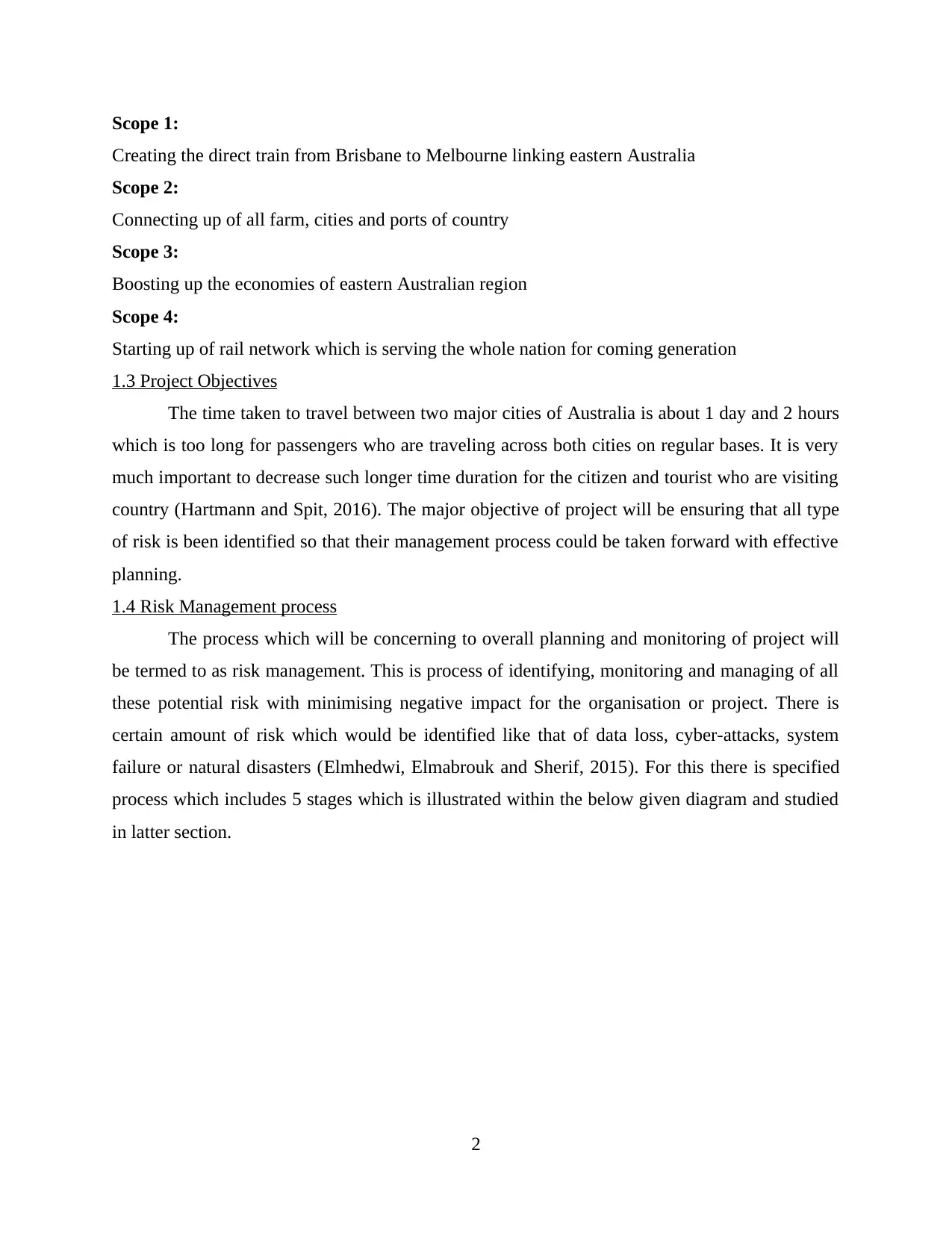
Scope 1:
Creating the direct train from Brisbane to Melbourne linking eastern Australia
Scope 2:
Connecting up of all farm, cities and ports of country
Scope 3:
Boosting up the economies of eastern Australian region
Scope 4:
Starting up of rail network which is serving the whole nation for coming generation
1.3 Project Objectives
The time taken to travel between two major cities of Australia is about 1 day and 2 hours
which is too long for passengers who are traveling across both cities on regular bases. It is very
much important to decrease such longer time duration for the citizen and tourist who are visiting
country (Hartmann and Spit, 2016). The major objective of project will be ensuring that all type
of risk is been identified so that their management process could be taken forward with effective
planning.
1.4 Risk Management process
The process which will be concerning to overall planning and monitoring of project will
be termed to as risk management. This is process of identifying, monitoring and managing of all
these potential risk with minimising negative impact for the organisation or project. There is
certain amount of risk which would be identified like that of data loss, cyber-attacks, system
failure or natural disasters (Elmhedwi, Elmabrouk and Sherif, 2015). For this there is specified
process which includes 5 stages which is illustrated within the below given diagram and studied
in latter section.
2
Creating the direct train from Brisbane to Melbourne linking eastern Australia
Scope 2:
Connecting up of all farm, cities and ports of country
Scope 3:
Boosting up the economies of eastern Australian region
Scope 4:
Starting up of rail network which is serving the whole nation for coming generation
1.3 Project Objectives
The time taken to travel between two major cities of Australia is about 1 day and 2 hours
which is too long for passengers who are traveling across both cities on regular bases. It is very
much important to decrease such longer time duration for the citizen and tourist who are visiting
country (Hartmann and Spit, 2016). The major objective of project will be ensuring that all type
of risk is been identified so that their management process could be taken forward with effective
planning.
1.4 Risk Management process
The process which will be concerning to overall planning and monitoring of project will
be termed to as risk management. This is process of identifying, monitoring and managing of all
these potential risk with minimising negative impact for the organisation or project. There is
certain amount of risk which would be identified like that of data loss, cyber-attacks, system
failure or natural disasters (Elmhedwi, Elmabrouk and Sherif, 2015). For this there is specified
process which includes 5 stages which is illustrated within the below given diagram and studied
in latter section.
2
⊘ This is a preview!⊘
Do you want full access?
Subscribe today to unlock all pages.

Trusted by 1+ million students worldwide
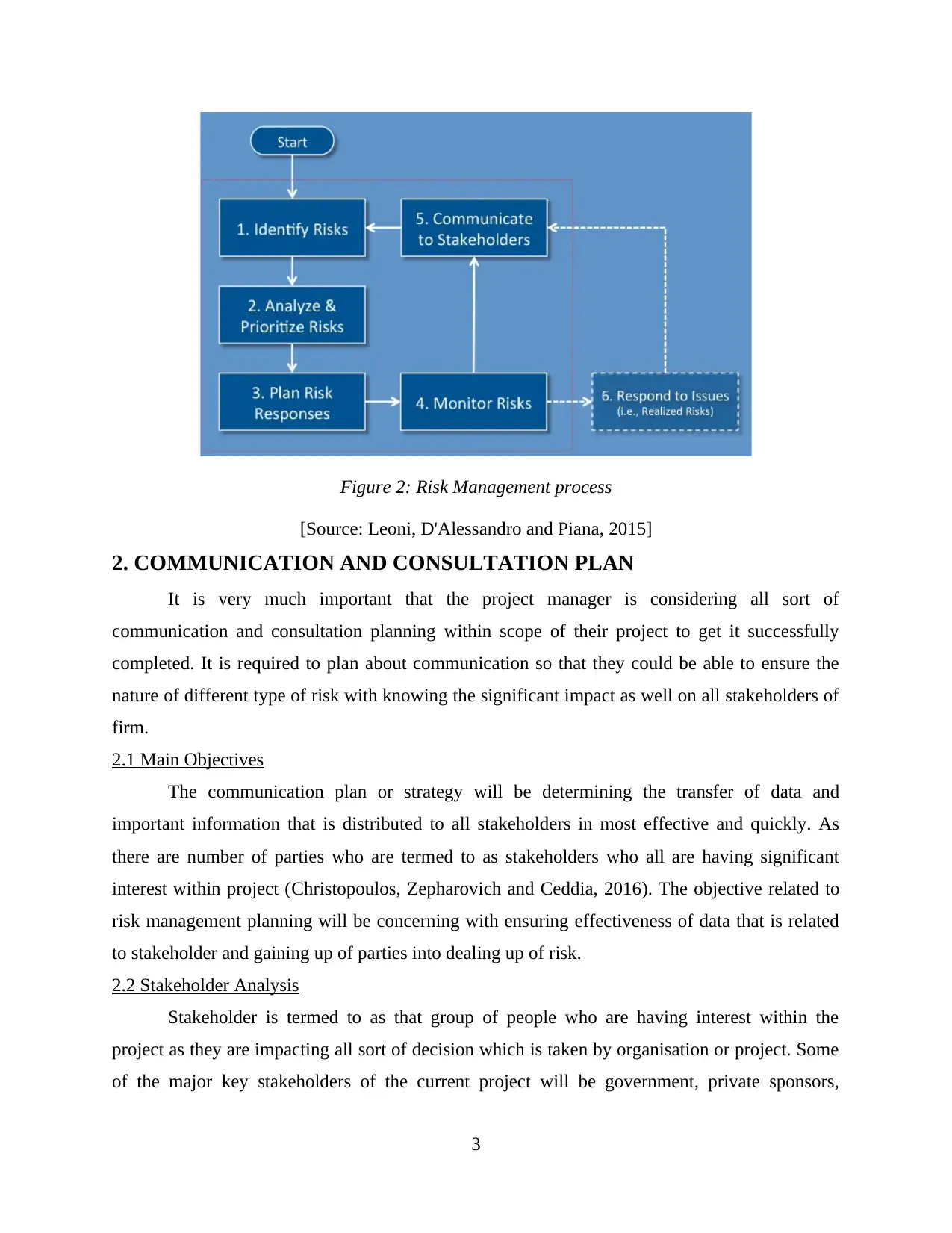
Figure 2: Risk Management process
[Source: Leoni, D'Alessandro and Piana, 2015]
2. COMMUNICATION AND CONSULTATION PLAN
It is very much important that the project manager is considering all sort of
communication and consultation planning within scope of their project to get it successfully
completed. It is required to plan about communication so that they could be able to ensure the
nature of different type of risk with knowing the significant impact as well on all stakeholders of
firm.
2.1 Main Objectives
The communication plan or strategy will be determining the transfer of data and
important information that is distributed to all stakeholders in most effective and quickly. As
there are number of parties who are termed to as stakeholders who all are having significant
interest within project (Christopoulos, Zepharovich and Ceddia, 2016). The objective related to
risk management planning will be concerning with ensuring effectiveness of data that is related
to stakeholder and gaining up of parties into dealing up of risk.
2.2 Stakeholder Analysis
Stakeholder is termed to as that group of people who are having interest within the
project as they are impacting all sort of decision which is taken by organisation or project. Some
of the major key stakeholders of the current project will be government, private sponsors,
3
[Source: Leoni, D'Alessandro and Piana, 2015]
2. COMMUNICATION AND CONSULTATION PLAN
It is very much important that the project manager is considering all sort of
communication and consultation planning within scope of their project to get it successfully
completed. It is required to plan about communication so that they could be able to ensure the
nature of different type of risk with knowing the significant impact as well on all stakeholders of
firm.
2.1 Main Objectives
The communication plan or strategy will be determining the transfer of data and
important information that is distributed to all stakeholders in most effective and quickly. As
there are number of parties who are termed to as stakeholders who all are having significant
interest within project (Christopoulos, Zepharovich and Ceddia, 2016). The objective related to
risk management planning will be concerning with ensuring effectiveness of data that is related
to stakeholder and gaining up of parties into dealing up of risk.
2.2 Stakeholder Analysis
Stakeholder is termed to as that group of people who are having interest within the
project as they are impacting all sort of decision which is taken by organisation or project. Some
of the major key stakeholders of the current project will be government, private sponsors,
3
Paraphrase This Document
Need a fresh take? Get an instant paraphrase of this document with our AI Paraphraser
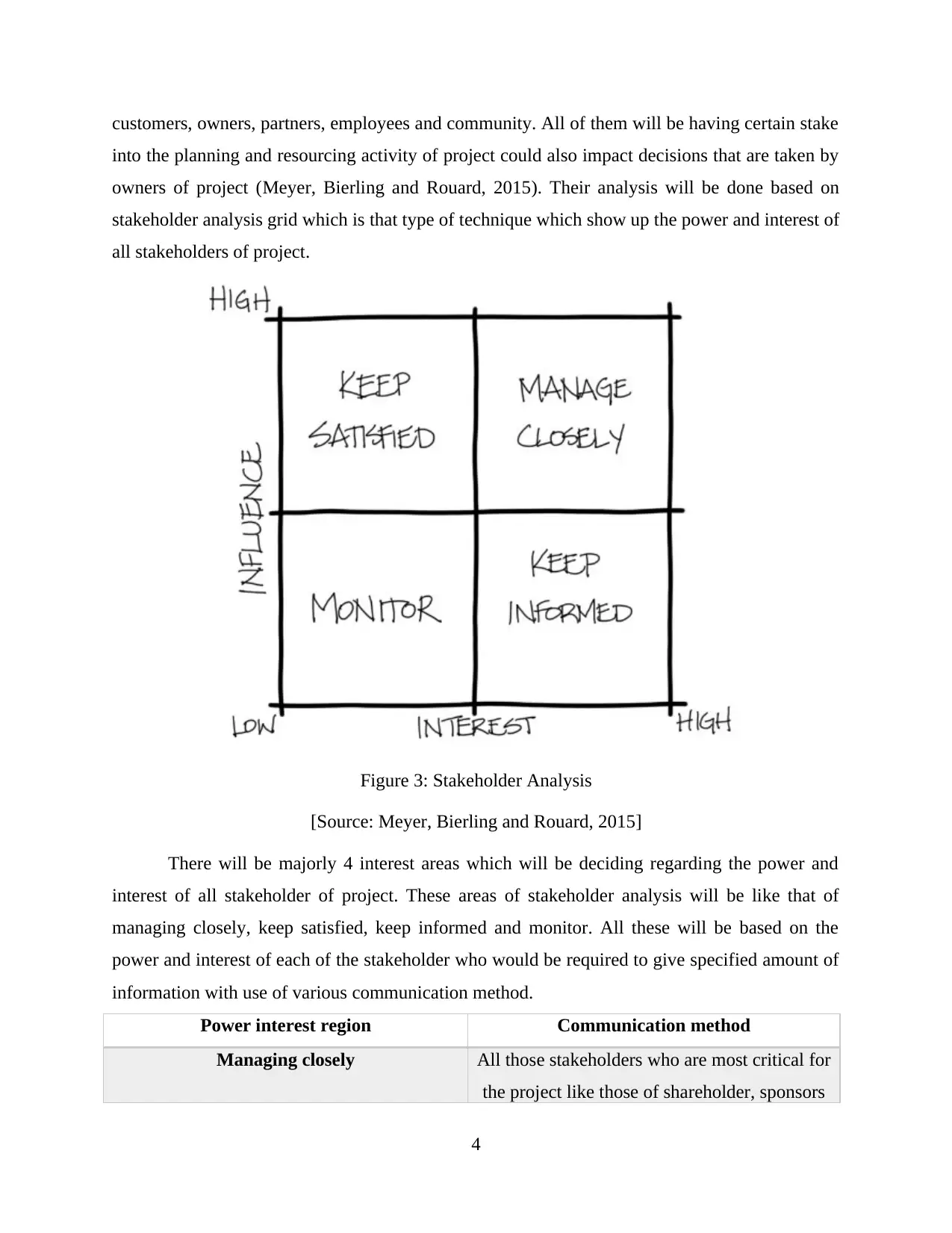
customers, owners, partners, employees and community. All of them will be having certain stake
into the planning and resourcing activity of project could also impact decisions that are taken by
owners of project (Meyer, Bierling and Rouard, 2015). Their analysis will be done based on
stakeholder analysis grid which is that type of technique which show up the power and interest of
all stakeholders of project.
Figure 3: Stakeholder Analysis
[Source: Meyer, Bierling and Rouard, 2015]
There will be majorly 4 interest areas which will be deciding regarding the power and
interest of all stakeholder of project. These areas of stakeholder analysis will be like that of
managing closely, keep satisfied, keep informed and monitor. All these will be based on the
power and interest of each of the stakeholder who would be required to give specified amount of
information with use of various communication method.
Power interest region Communication method
Managing closely All those stakeholders who are most critical for
the project like those of shareholder, sponsors
4
into the planning and resourcing activity of project could also impact decisions that are taken by
owners of project (Meyer, Bierling and Rouard, 2015). Their analysis will be done based on
stakeholder analysis grid which is that type of technique which show up the power and interest of
all stakeholders of project.
Figure 3: Stakeholder Analysis
[Source: Meyer, Bierling and Rouard, 2015]
There will be majorly 4 interest areas which will be deciding regarding the power and
interest of all stakeholder of project. These areas of stakeholder analysis will be like that of
managing closely, keep satisfied, keep informed and monitor. All these will be based on the
power and interest of each of the stakeholder who would be required to give specified amount of
information with use of various communication method.
Power interest region Communication method
Managing closely All those stakeholders who are most critical for
the project like those of shareholder, sponsors
4
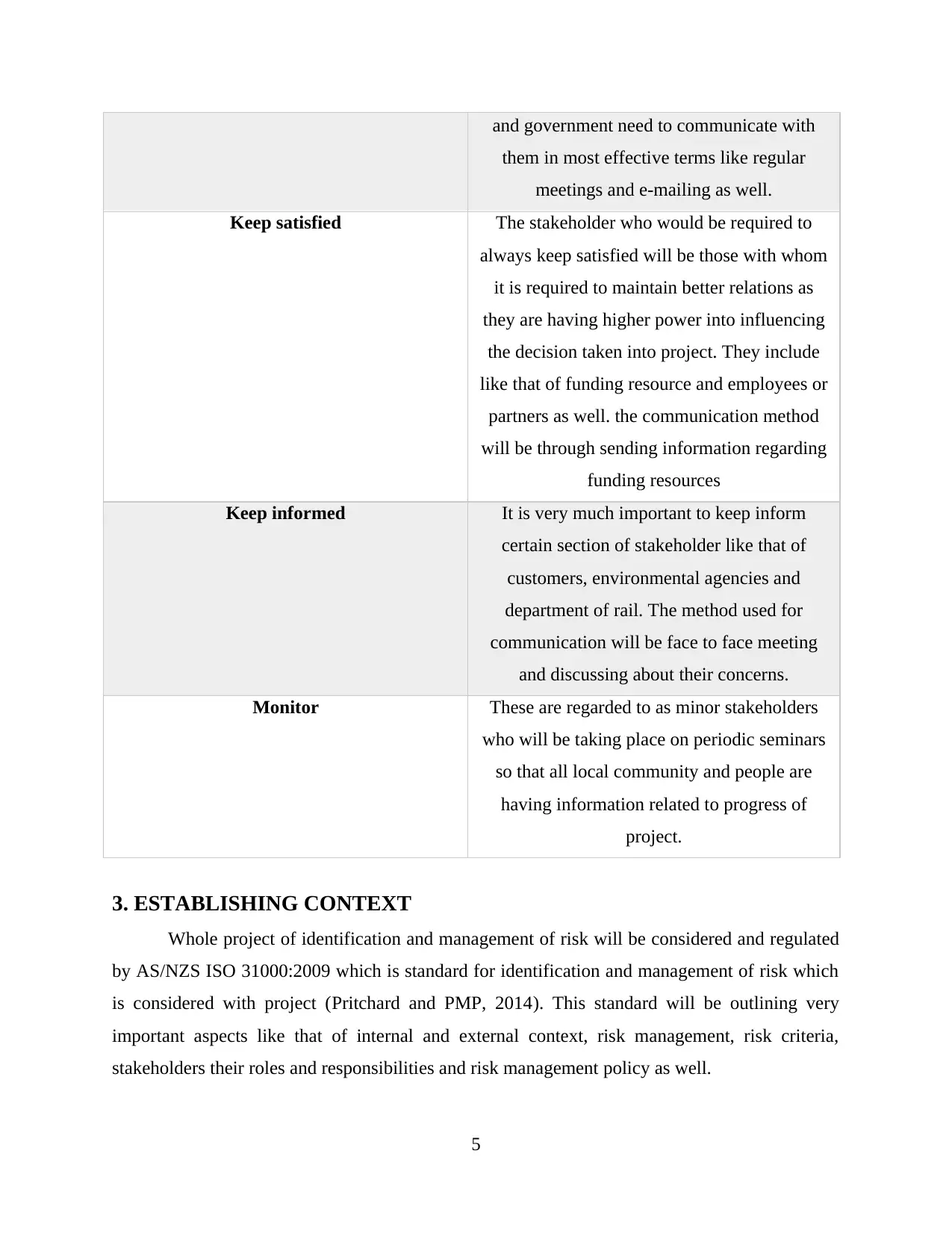
and government need to communicate with
them in most effective terms like regular
meetings and e-mailing as well.
Keep satisfied The stakeholder who would be required to
always keep satisfied will be those with whom
it is required to maintain better relations as
they are having higher power into influencing
the decision taken into project. They include
like that of funding resource and employees or
partners as well. the communication method
will be through sending information regarding
funding resources
Keep informed It is very much important to keep inform
certain section of stakeholder like that of
customers, environmental agencies and
department of rail. The method used for
communication will be face to face meeting
and discussing about their concerns.
Monitor These are regarded to as minor stakeholders
who will be taking place on periodic seminars
so that all local community and people are
having information related to progress of
project.
3. ESTABLISHING CONTEXT
Whole project of identification and management of risk will be considered and regulated
by AS/NZS ISO 31000:2009 which is standard for identification and management of risk which
is considered with project (Pritchard and PMP, 2014). This standard will be outlining very
important aspects like that of internal and external context, risk management, risk criteria,
stakeholders their roles and responsibilities and risk management policy as well.
5
them in most effective terms like regular
meetings and e-mailing as well.
Keep satisfied The stakeholder who would be required to
always keep satisfied will be those with whom
it is required to maintain better relations as
they are having higher power into influencing
the decision taken into project. They include
like that of funding resource and employees or
partners as well. the communication method
will be through sending information regarding
funding resources
Keep informed It is very much important to keep inform
certain section of stakeholder like that of
customers, environmental agencies and
department of rail. The method used for
communication will be face to face meeting
and discussing about their concerns.
Monitor These are regarded to as minor stakeholders
who will be taking place on periodic seminars
so that all local community and people are
having information related to progress of
project.
3. ESTABLISHING CONTEXT
Whole project of identification and management of risk will be considered and regulated
by AS/NZS ISO 31000:2009 which is standard for identification and management of risk which
is considered with project (Pritchard and PMP, 2014). This standard will be outlining very
important aspects like that of internal and external context, risk management, risk criteria,
stakeholders their roles and responsibilities and risk management policy as well.
5
⊘ This is a preview!⊘
Do you want full access?
Subscribe today to unlock all pages.

Trusted by 1+ million students worldwide
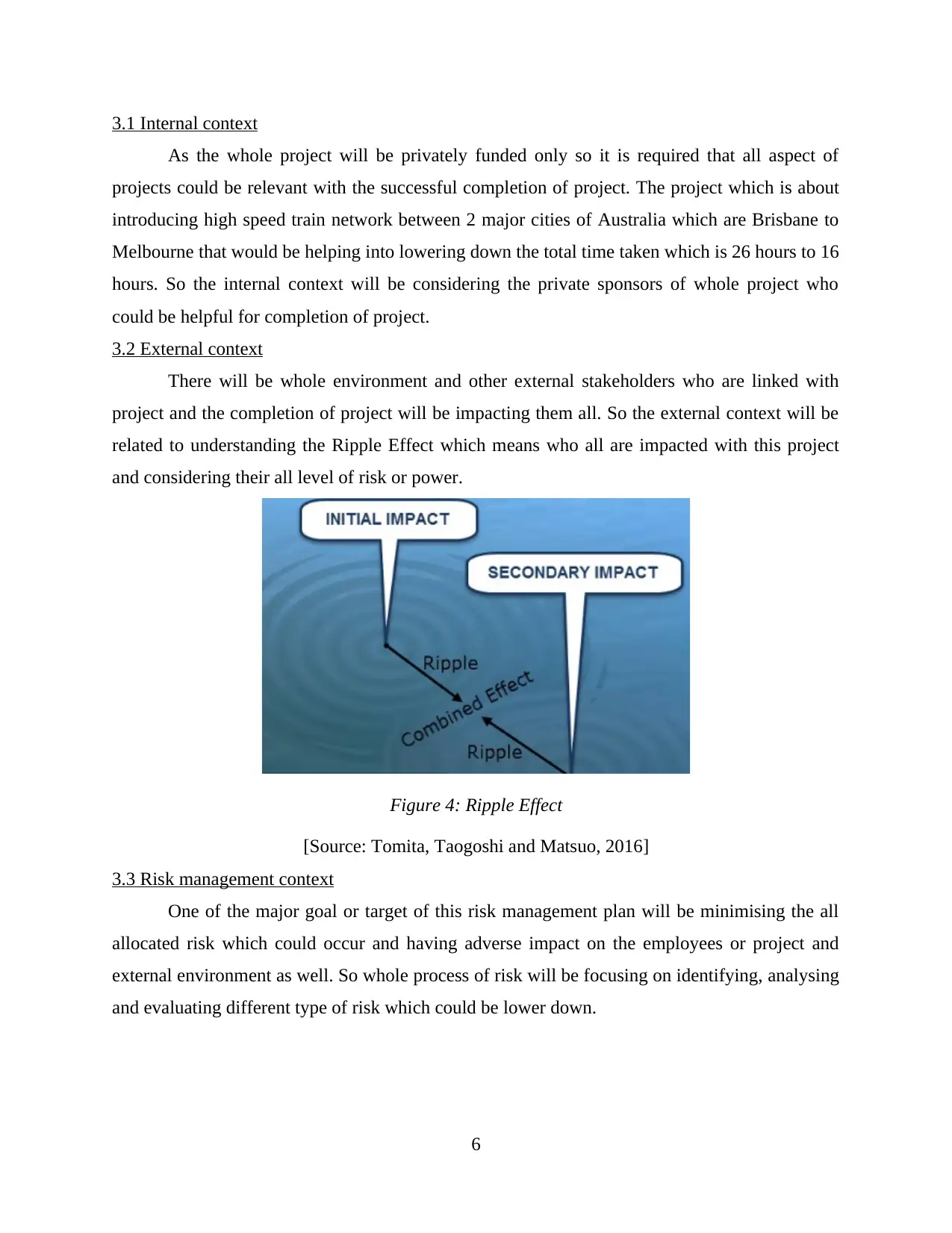
3.1 Internal context
As the whole project will be privately funded only so it is required that all aspect of
projects could be relevant with the successful completion of project. The project which is about
introducing high speed train network between 2 major cities of Australia which are Brisbane to
Melbourne that would be helping into lowering down the total time taken which is 26 hours to 16
hours. So the internal context will be considering the private sponsors of whole project who
could be helpful for completion of project.
3.2 External context
There will be whole environment and other external stakeholders who are linked with
project and the completion of project will be impacting them all. So the external context will be
related to understanding the Ripple Effect which means who all are impacted with this project
and considering their all level of risk or power.
Figure 4: Ripple Effect
[Source: Tomita, Taogoshi and Matsuo, 2016]
3.3 Risk management context
One of the major goal or target of this risk management plan will be minimising the all
allocated risk which could occur and having adverse impact on the employees or project and
external environment as well. So whole process of risk will be focusing on identifying, analysing
and evaluating different type of risk which could be lower down.
6
As the whole project will be privately funded only so it is required that all aspect of
projects could be relevant with the successful completion of project. The project which is about
introducing high speed train network between 2 major cities of Australia which are Brisbane to
Melbourne that would be helping into lowering down the total time taken which is 26 hours to 16
hours. So the internal context will be considering the private sponsors of whole project who
could be helpful for completion of project.
3.2 External context
There will be whole environment and other external stakeholders who are linked with
project and the completion of project will be impacting them all. So the external context will be
related to understanding the Ripple Effect which means who all are impacted with this project
and considering their all level of risk or power.
Figure 4: Ripple Effect
[Source: Tomita, Taogoshi and Matsuo, 2016]
3.3 Risk management context
One of the major goal or target of this risk management plan will be minimising the all
allocated risk which could occur and having adverse impact on the employees or project and
external environment as well. So whole process of risk will be focusing on identifying, analysing
and evaluating different type of risk which could be lower down.
6
Paraphrase This Document
Need a fresh take? Get an instant paraphrase of this document with our AI Paraphraser
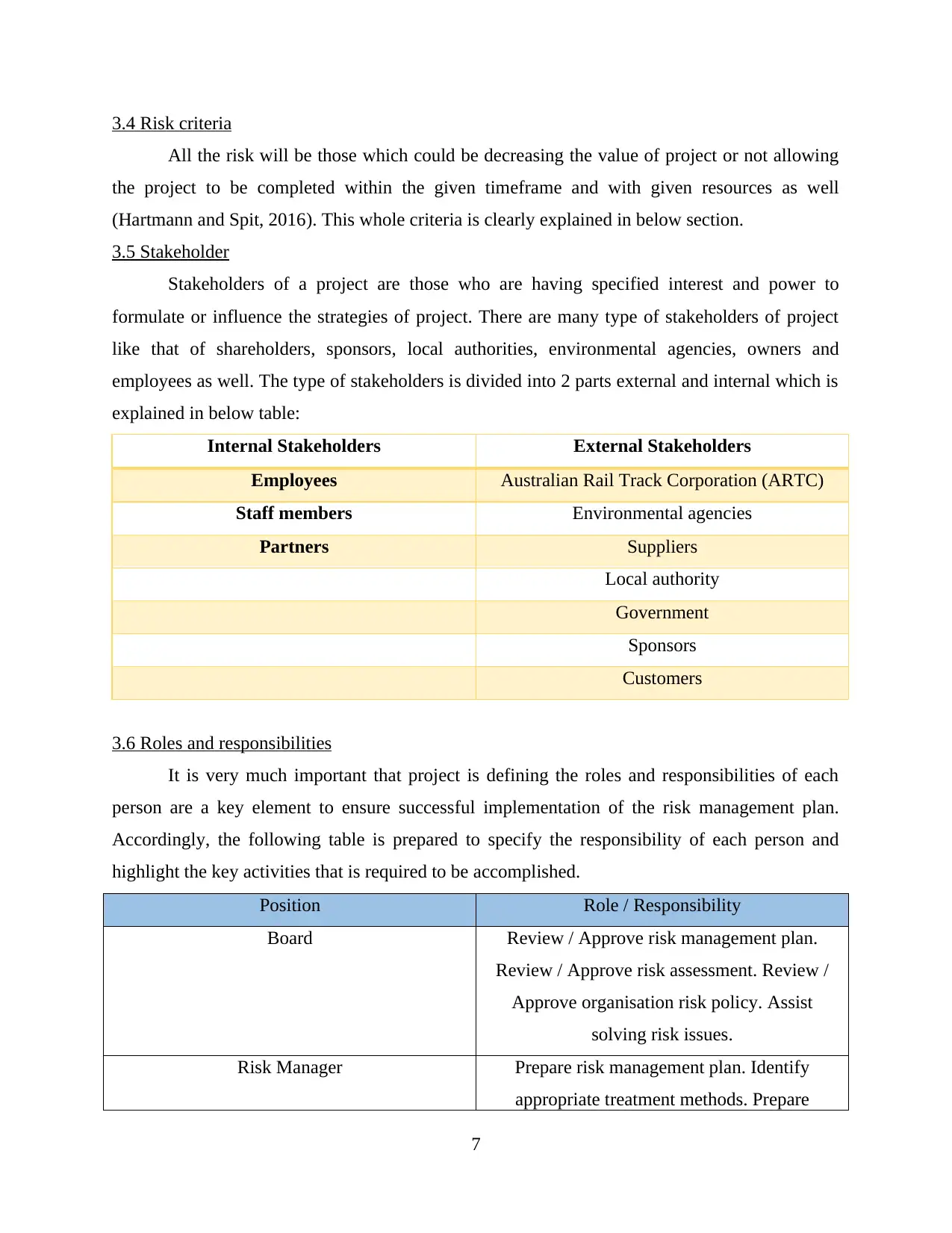
3.4 Risk criteria
All the risk will be those which could be decreasing the value of project or not allowing
the project to be completed within the given timeframe and with given resources as well
(Hartmann and Spit, 2016). This whole criteria is clearly explained in below section.
3.5 Stakeholder
Stakeholders of a project are those who are having specified interest and power to
formulate or influence the strategies of project. There are many type of stakeholders of project
like that of shareholders, sponsors, local authorities, environmental agencies, owners and
employees as well. The type of stakeholders is divided into 2 parts external and internal which is
explained in below table:
Internal Stakeholders External Stakeholders
Employees Australian Rail Track Corporation (ARTC)
Staff members Environmental agencies
Partners Suppliers
Local authority
Government
Sponsors
Customers
3.6 Roles and responsibilities
It is very much important that project is defining the roles and responsibilities of each
person are a key element to ensure successful implementation of the risk management plan.
Accordingly, the following table is prepared to specify the responsibility of each person and
highlight the key activities that is required to be accomplished.
Position Role / Responsibility
Board Review / Approve risk management plan.
Review / Approve risk assessment. Review /
Approve organisation risk policy. Assist
solving risk issues.
Risk Manager Prepare risk management plan. Identify
appropriate treatment methods. Prepare
7
All the risk will be those which could be decreasing the value of project or not allowing
the project to be completed within the given timeframe and with given resources as well
(Hartmann and Spit, 2016). This whole criteria is clearly explained in below section.
3.5 Stakeholder
Stakeholders of a project are those who are having specified interest and power to
formulate or influence the strategies of project. There are many type of stakeholders of project
like that of shareholders, sponsors, local authorities, environmental agencies, owners and
employees as well. The type of stakeholders is divided into 2 parts external and internal which is
explained in below table:
Internal Stakeholders External Stakeholders
Employees Australian Rail Track Corporation (ARTC)
Staff members Environmental agencies
Partners Suppliers
Local authority
Government
Sponsors
Customers
3.6 Roles and responsibilities
It is very much important that project is defining the roles and responsibilities of each
person are a key element to ensure successful implementation of the risk management plan.
Accordingly, the following table is prepared to specify the responsibility of each person and
highlight the key activities that is required to be accomplished.
Position Role / Responsibility
Board Review / Approve risk management plan.
Review / Approve risk assessment. Review /
Approve organisation risk policy. Assist
solving risk issues.
Risk Manager Prepare risk management plan. Identify
appropriate treatment methods. Prepare
7
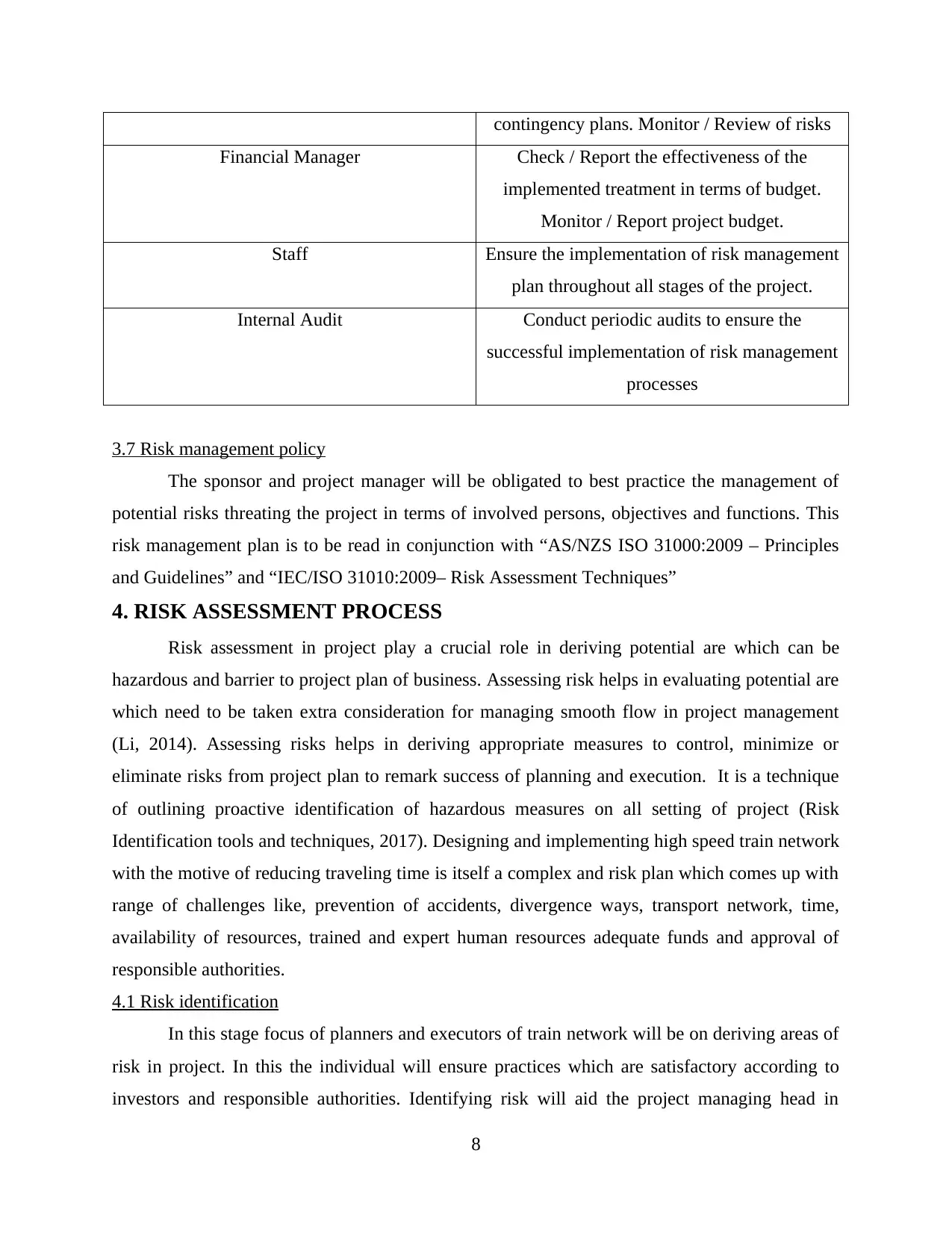
contingency plans. Monitor / Review of risks
Financial Manager Check / Report the effectiveness of the
implemented treatment in terms of budget.
Monitor / Report project budget.
Staff Ensure the implementation of risk management
plan throughout all stages of the project.
Internal Audit Conduct periodic audits to ensure the
successful implementation of risk management
processes
3.7 Risk management policy
The sponsor and project manager will be obligated to best practice the management of
potential risks threating the project in terms of involved persons, objectives and functions. This
risk management plan is to be read in conjunction with “AS/NZS ISO 31000:2009 – Principles
and Guidelines” and “IEC/ISO 31010:2009– Risk Assessment Techniques”
4. RISK ASSESSMENT PROCESS
Risk assessment in project play a crucial role in deriving potential are which can be
hazardous and barrier to project plan of business. Assessing risk helps in evaluating potential are
which need to be taken extra consideration for managing smooth flow in project management
(Li, 2014). Assessing risks helps in deriving appropriate measures to control, minimize or
eliminate risks from project plan to remark success of planning and execution. It is a technique
of outlining proactive identification of hazardous measures on all setting of project (Risk
Identification tools and techniques, 2017). Designing and implementing high speed train network
with the motive of reducing traveling time is itself a complex and risk plan which comes up with
range of challenges like, prevention of accidents, divergence ways, transport network, time,
availability of resources, trained and expert human resources adequate funds and approval of
responsible authorities.
4.1 Risk identification
In this stage focus of planners and executors of train network will be on deriving areas of
risk in project. In this the individual will ensure practices which are satisfactory according to
investors and responsible authorities. Identifying risk will aid the project managing head in
8
Financial Manager Check / Report the effectiveness of the
implemented treatment in terms of budget.
Monitor / Report project budget.
Staff Ensure the implementation of risk management
plan throughout all stages of the project.
Internal Audit Conduct periodic audits to ensure the
successful implementation of risk management
processes
3.7 Risk management policy
The sponsor and project manager will be obligated to best practice the management of
potential risks threating the project in terms of involved persons, objectives and functions. This
risk management plan is to be read in conjunction with “AS/NZS ISO 31000:2009 – Principles
and Guidelines” and “IEC/ISO 31010:2009– Risk Assessment Techniques”
4. RISK ASSESSMENT PROCESS
Risk assessment in project play a crucial role in deriving potential are which can be
hazardous and barrier to project plan of business. Assessing risk helps in evaluating potential are
which need to be taken extra consideration for managing smooth flow in project management
(Li, 2014). Assessing risks helps in deriving appropriate measures to control, minimize or
eliminate risks from project plan to remark success of planning and execution. It is a technique
of outlining proactive identification of hazardous measures on all setting of project (Risk
Identification tools and techniques, 2017). Designing and implementing high speed train network
with the motive of reducing traveling time is itself a complex and risk plan which comes up with
range of challenges like, prevention of accidents, divergence ways, transport network, time,
availability of resources, trained and expert human resources adequate funds and approval of
responsible authorities.
4.1 Risk identification
In this stage focus of planners and executors of train network will be on deriving areas of
risk in project. In this the individual will ensure practices which are satisfactory according to
investors and responsible authorities. Identifying risk will aid the project managing head in
8
⊘ This is a preview!⊘
Do you want full access?
Subscribe today to unlock all pages.

Trusted by 1+ million students worldwide
1 out of 22
Related Documents
Your All-in-One AI-Powered Toolkit for Academic Success.
+13062052269
info@desklib.com
Available 24*7 on WhatsApp / Email
![[object Object]](/_next/static/media/star-bottom.7253800d.svg)
Unlock your academic potential
Copyright © 2020–2025 A2Z Services. All Rights Reserved. Developed and managed by ZUCOL.





